
“Some people go to the movies to be reminded that everything’s okay. I don’t make those kinds of movies. That, to me, is a lie. Everything’s not okay.”
The gruesome killings of a zealous serial killer in Se7en; a tapestry of betrayals in The Social Network; a provoked psychopath hell-bent on taking revenge in Gone Girl; true stories of a serial-killer depicted with daunting details in Zodiac; a rapist in power taking advantage of devastated girls in The Girl With Dragon Tattoo; a tragic look into the psychology of serial killers in Mindhunter; and an insomniac on the loose in Fight Club are only a glimpse of Fincher’s fascination with making you uncomfortable.
After watching the making of Butch Cassidy and the Sundance Kid when he was only eight years old, Fincher knew that he wanted to be a director. He worked in at Industrial Light and Magic (ILM) for two years as an assistant cameraman. Making the smoking fetus for the American Cancer Society put him on the spotlight, so the next step for him was directing commercials and music videos, which lasted for seven years. Fincher went on to establish Propaganda, the biggest music video company in Hollywood. The young, naïve Fincher kicked off his film career by being at the helm of Alien 3. The disdain he has for this film borders on comedy: “I was sodomized ritualistically for two years. There is no one problem with a 65 million dollar fucked-up first-time filmmaking. I made a crucial error of listening to the people who were paying for the movie”.
“Films are not finished; they’re abandoned”
You can get an inkling of Fincher’s perfectionism in that quote. He’s famous for numerous takes. The reason for which is to get rid of the actors’ earnestness, a process that involves going beyond muscle memory. “Usually by take 17 earnestness is gone. I want you (the actor) to know exactly where to sit in that chair, I want you to be really comfortable. You come in and you throw your coat on couch. When you have done that 15 times, it starts to look like you live there. Conversations between two twin brothers that are supposed to overlap, they have to get to a point that not only they can finish each other’s sentences, but they are finishing each other’s sentences, so you have to make the actors jump in at the right point. I’m always watching for first, the technical, then the believable and then, I’m looking for the connection”.
Perfection lies in details. Thanks to his experience working at ILM, Fincher is well-versed in visual effects and CGI. He employs them to service the story, not to impress. Consider the long take of Panic Room. The omniscient camera travels the whole geometry of the scene while giving you other crucial details in only a couple of minutes. You get an idea of the distance between protagonists and antagonists. You see how they break into the house and you can see their escape routes. In Zodiac, a period film, he uses visual effects to double down on historical authenticity, achieving the highest possible detail. There are innumerate instances that are beyond the scope of this article, so I recommend this video for those interested.
“In film, we sculpt time, we sculpt behavior, and we sculpt light.”
Fincher synchronizes the camera with the behavior. The character moves; the camera moves. The character stops; the camera stops. The character runs; the camera runs. Character slows down; the camera slows down, and so on. This is the fulcrum of his direction, which benefits from numerous takes. Take the following shot from Zodiac. Notice how the direction of the eyes motivates the camera.
Or this scene shot from Fight Club. When The Narrator (Edward Norton) gets hit and moves back, the camera moves with him, selling the momentum of the hit.
Fincher’s camera is omniscient, fluid, and stable. He saves the shaky camera for the most fitting moments - like chasing John Doe in Se7en. This sporadic - and more effective - usage also applies to close-ups. He goes to close up to show a vital piece of information in dialogue, display subjects of interest, and to capture the character’s reaction. Take the interrogation scene in Zodiac. We get a wide shot of the room to understand the geometry and the blocking of the characters, three detectives confronting one suspect. Most of the shots during the exchange are over-the-shoulder. Fincher goes to close-up to show his watch; medium close-up to show his navy boots and to capture the reactions.
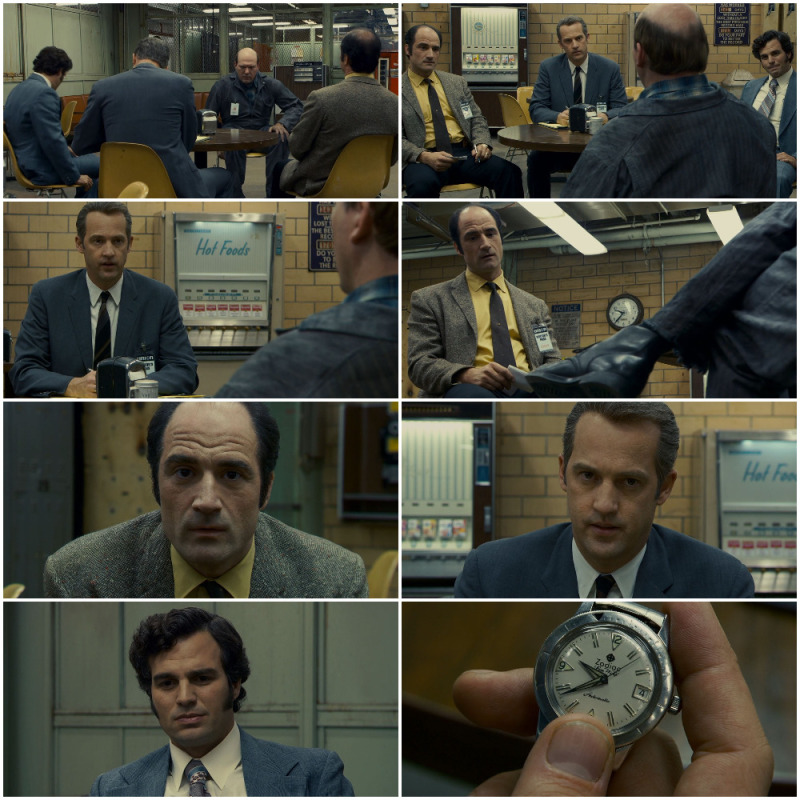
Another distinctive feature of Fincher’s films is his choice of color palette. His films, from Zodiac onward, in particular, have a desaturated yellow-blue-green color palette, which produces a dark, slick, stylized image grounded in realism. If you’re interested in knowing more about this, I suggest this article.
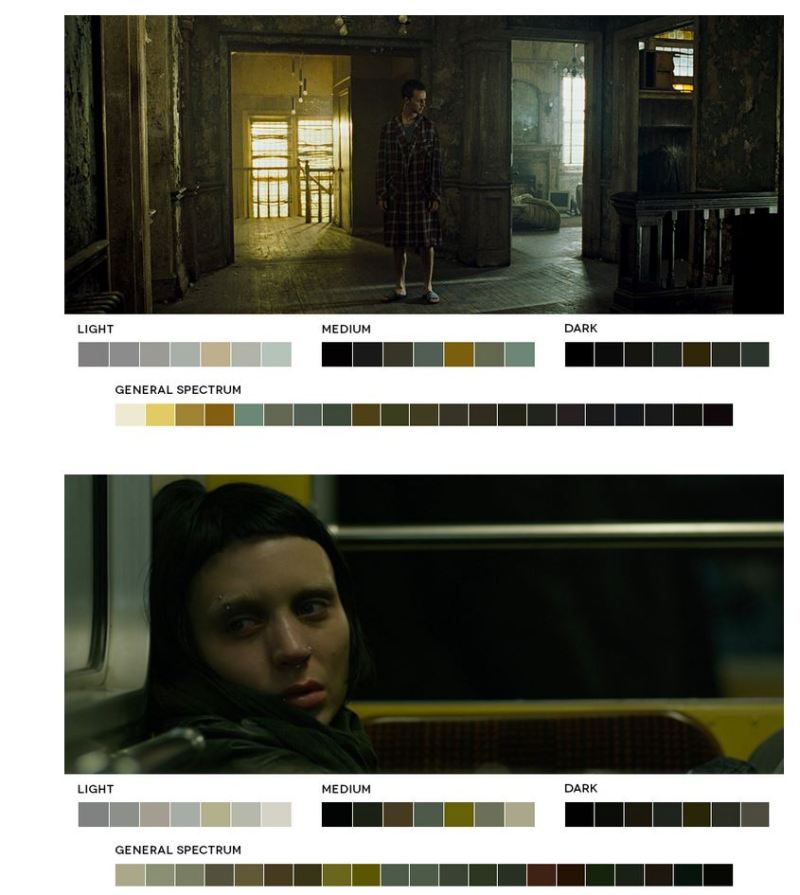
Top 5 Scenes
5
The Social Network – The Opening Scene
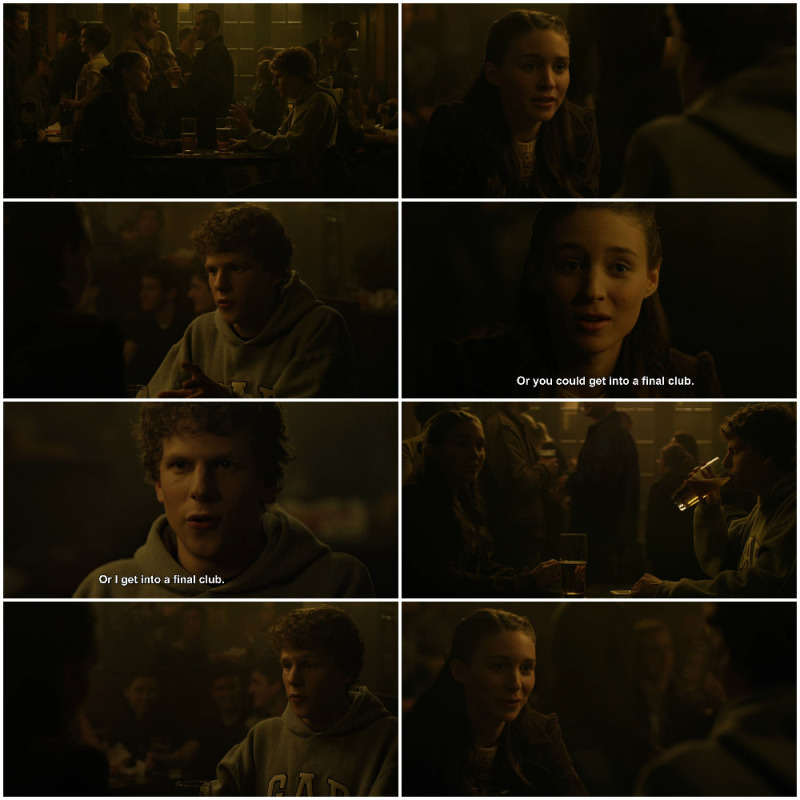
The Social Network might be my favorite collaboration between two artists at the top of their game. Aron Sorkin’s ping-pong dialogue meets with Fincher’s meticulous direction. 99 takes have been shot with five setups, each averaging 20 takes. It’s 9 pages that should be done in 4 and a half minutes with “explosive, aggressive, thinking-out-loud” dialogue. And the final result is a perfection in acting. Mark speaks super fast while maintaining his arrogance and insecurity. Erica, in the last minute, exudes exasperation. Her facial expressions and how she emphasizes some words like “slept,” “friend,” and “sufficiently” sell that irritated emotional state. We start with a wide shot, establishing the vibe and geometry of the scene. The conversation is mostly shot with over-the-shoulder camera angles. Fincher goes to close-up when a specific topic comes up: final club, indicating its importance. We get back to wide shot but this time it’s closer, indicating that we know them more. The shots keep alternating between over-the-shoulder and close-up depending on the content. And finally, we get the last deadly close-up that leaves Mark deflated.
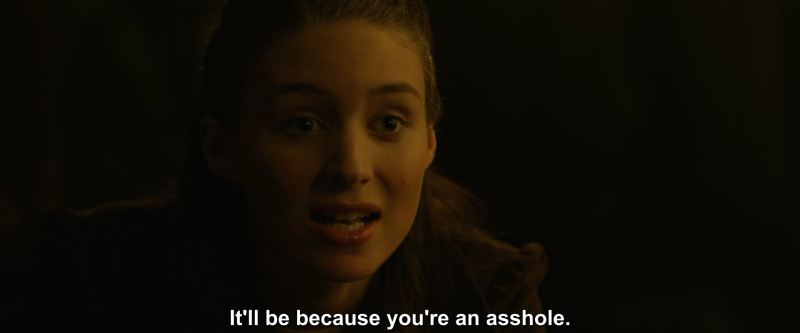
4
The Social Network - The Betrayal Scene
Besides the script, there are a few things that struck me the most in this scene. First, it’s the blocking of actors in the deposition room. As Eduardo explains the event, his back is turned at Mark, showing the clear conflict between the two. What makes it special is this beat:
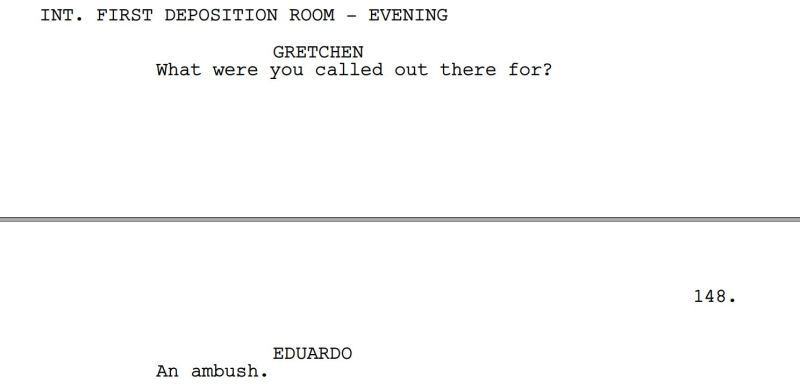
which Fincher brings to life in this way:
It sells the moment much more effectively.
Second, it’s how he goes into the POV shot, which is followed by moving the camera with the character in this beat:
Combined with the low angle, it conveys the intended momentum and aggression, culminating in breaking the laptop into pieces.
And third, it’s the reactions throughout the whole scene, enriching the subtext.
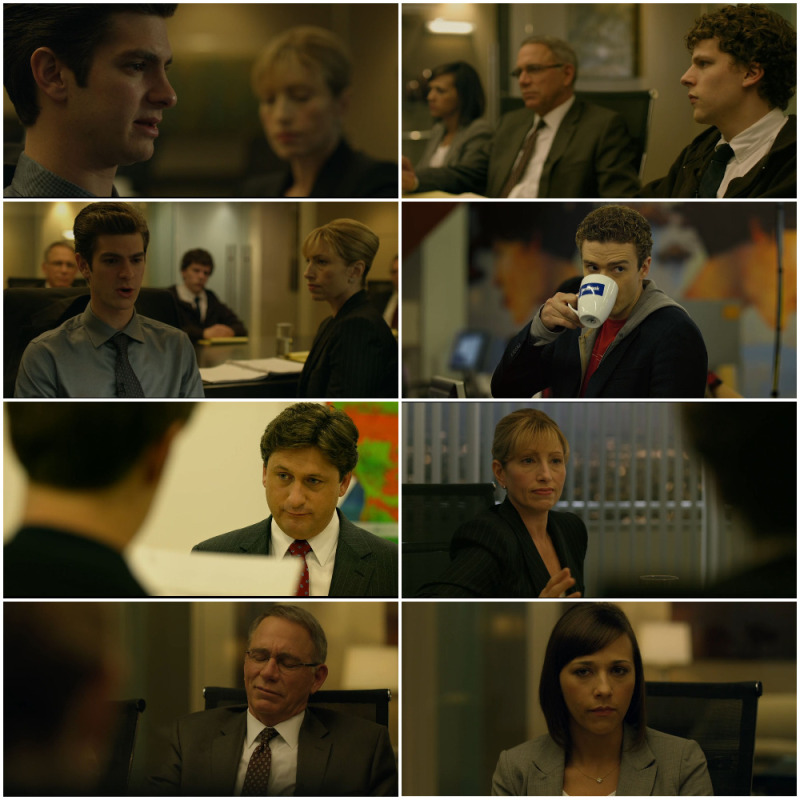
3
Mindhuner – Season 1 Episode 10
The Context of the Scene:
Dumped by his girlfriend and reproached by his colleagues, Holden is distressed and humiliated. He goes to visit Ed Kamper, his beloved serial killer, not out of concern, but out of desperation. We have no idea how this meeting will go down, but Ed Kamper alone is enough to ratchet up our excitement.
Scene Breakdown
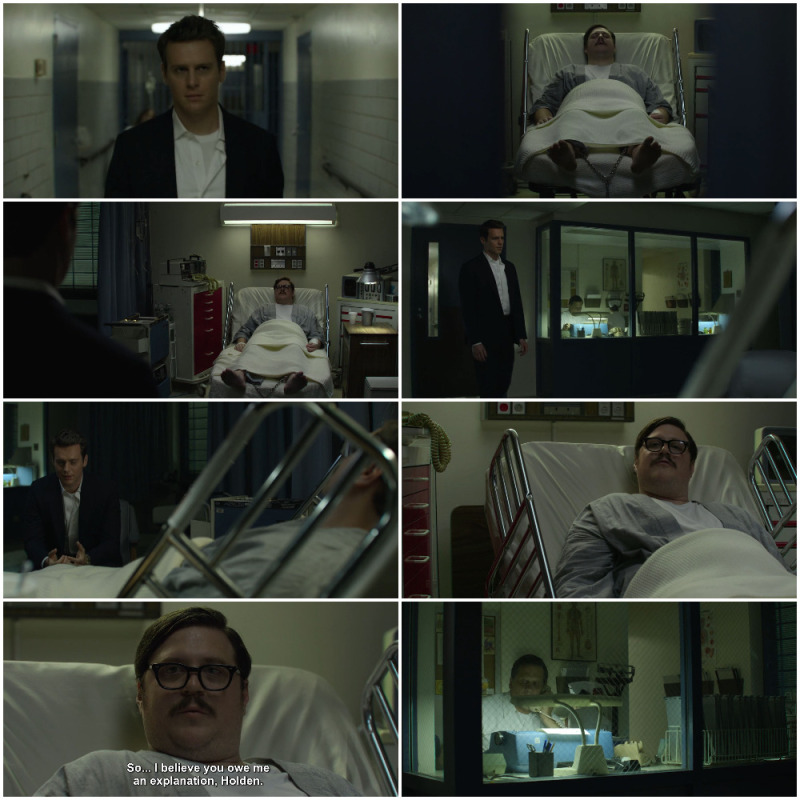
We get a wide shot when Holden enters the room, establishing the geometry and the people involved. The conversation starts in peace with medium and wide shots of the two characters. As Ed reveals how upset he is over being ignored for several weeks, for the first time, we get a close-up of his reaction. We are shown the nurses for the second time, making us inquisitive about their importance.
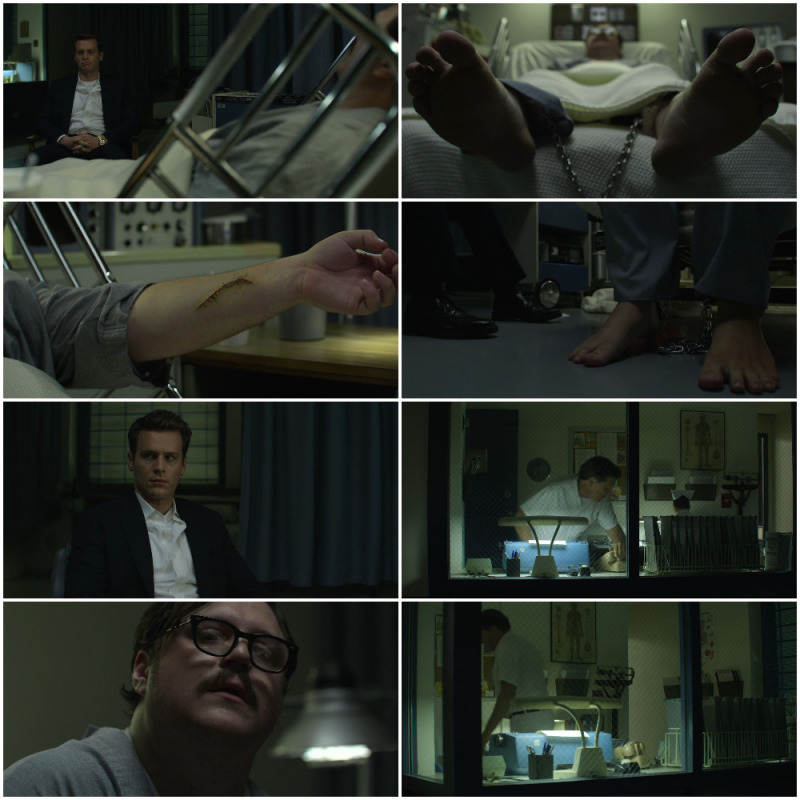
We get back to wide and medium shots when Ed moves onto another subject, tension is relieved. Fincher gives you clues to predict the next moment. This menacing close up of Ed’s legs and a few shots of nurses leaving the room are instances of this. Ed thumps the ground with his legs. Worried and anxious, Holden side-glances the nurses.
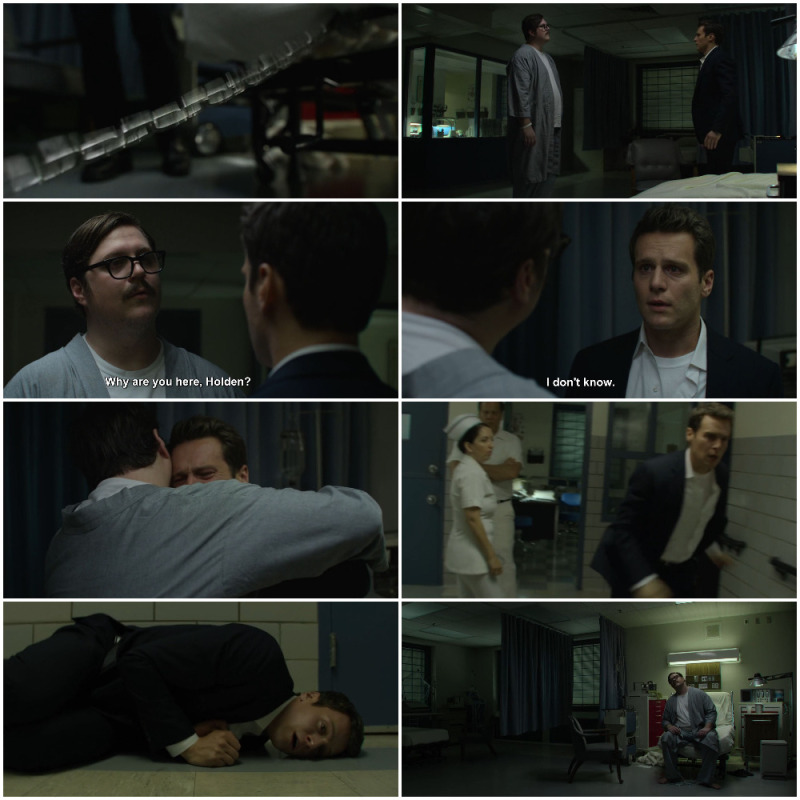
Ed is preoccupying Holden with some insights. Once he is sure of being alone with him, stands up abruptly and confronts him head to head. This quick close up of the chain rattling as he stands up elicits a startling emotion, bordering on a jump-scare. Now that the enigmatic Ed has the upper-hand, what’s he gonna do? Tension spikes as he gets closer and closer to Holden. With a chilling grin, Ed taps on Holden’s shoulder and hugs him. He can suffocate him right there, but lets go. Holden, overwrought and traumatized, storms off the room with Led Zeppelin rocking in the background. Once again, Fincher saves the shaky camera for the most appropriate moment, maximizing its effect.
(Read Nicholas Lee’s review of the first season).
2
Zodiac - The Basement Scene
The Context of the Scene:
We are over two hours into the film, desperately trying to catch the Zodiac. So much information is gleaned, so many clues are followed, but to no avail. Our protagonist, Graysmith, has another promising lead. We are going to speak to a guy named Vaughn about the next suspect: Rick Marshall. He has supposedly left a film canister in Vaughn’s possession and has also made a poster. The handwriting on that poster is the closest match to that of Zodiac’s. Vaughn invites Graysmith to his house.
By the way, not a lot of people have basements in California.
Scene Breakdown:
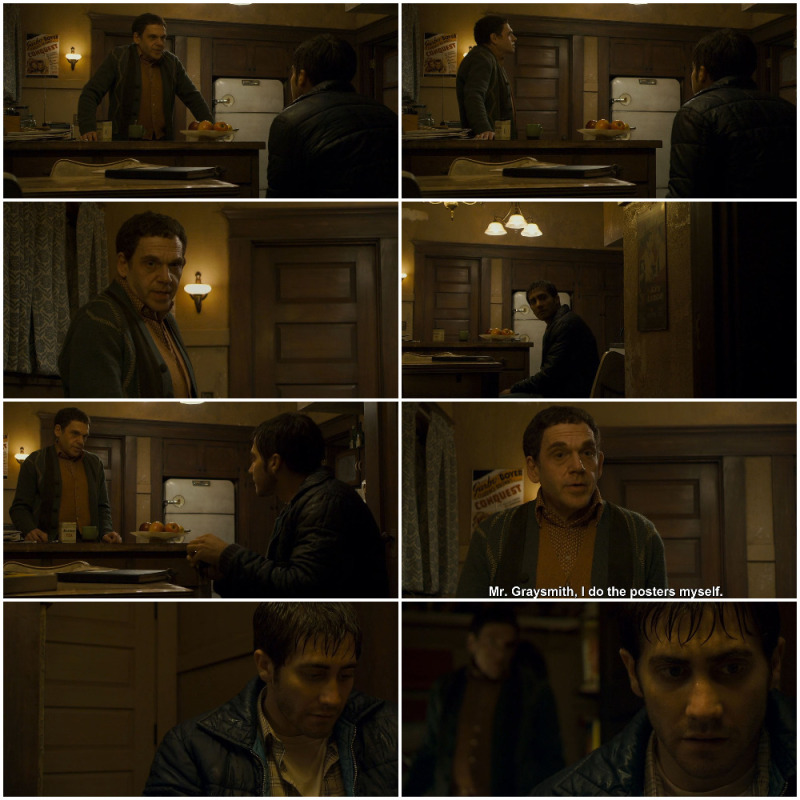
As Vaughn guides Graysmith into the house, we get familiar with its geometry. As Graysmith comes to sit, the camera dollies back into a master shot to have both characters in one single frame, avoiding unnecessary cuts. Graysmith starts asking questions. Once he brings up the Zodiac, Vaughn looks sideways, as if he’s hiding something. For the first time, we get a medium shot of him emphasizing his lack of knowledge about Rick’s whereabouts. Tension is relieved when Vaughn keeps cooperating and shots are alternated between medium and master. Then the poster comes into play. Graysmith tells him how the handwriting of the poster is the closest match and then, we get a medium shot of Vaughn saying “Mr. Graysmith, I do the posters myself. That’s my handwriting.” Tension spikes. We, just like Graysmith, are filled with dread that Vaughn might be the Zodiac. The moment lingers with a medium shot of Graysmith showing a door behind him. Turns out it’s the basement door. For the first time, we get a close-up two-shot, with Vaughn standing behind him; an impending threat.
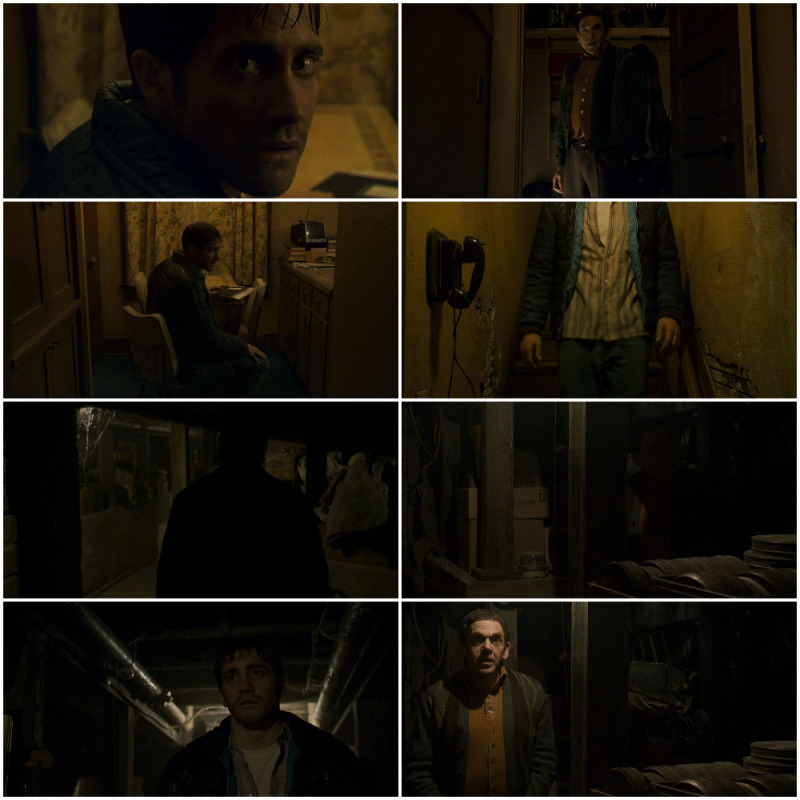
Vaughn is framed in low angle, emphasizing his power. Graysmith is framed in high angle, conveying his frailty. Quailed and anxious, we go down to the basement. The film, through the dark and noisy surrounding, capitalizes on our suspicion to fuel the suspenseful scene. Vaughn is framed in darkness and Graysmith dreads the creaky sound of the ceiling. The camera dollies in on him as the suspicious sound intensifies, further inducing the threat. Graysmith outright asks him if he lives alone and he, with a deadly calmness, responds “would you like to go upstairs and check?”
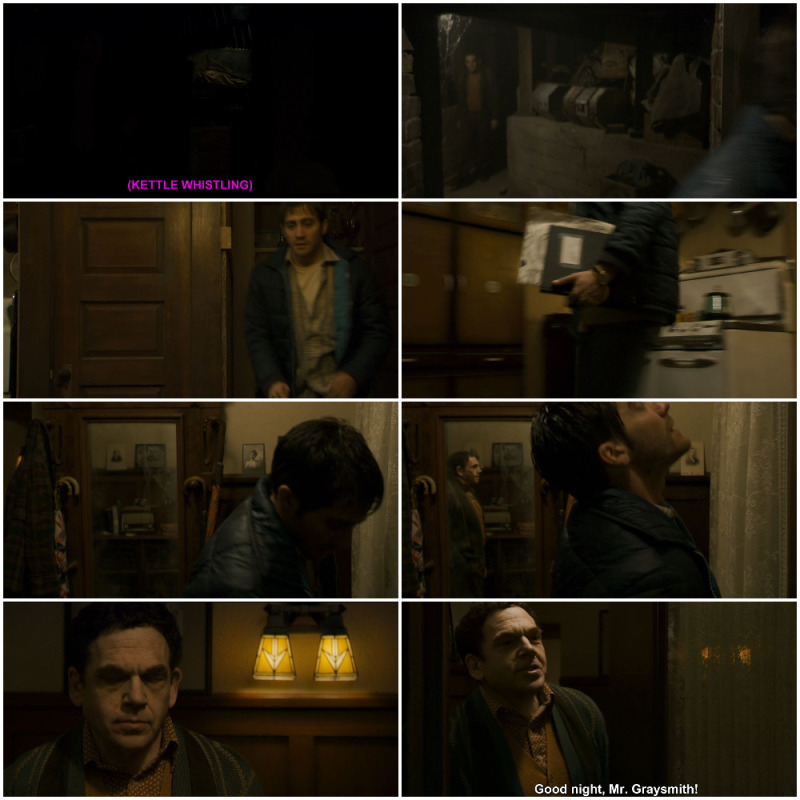
Almost certain he is doomed, Graysmith tries to escape. As he runs upstairs, Fincher keeps Vaughn in the frame, as if Vaughn is chasing him, and uses the kettle’s aggressive whistling to sculpt further tension. Graysmith is confronted with a locked door. Suddenly, Vaughn appears in the mirror. His ambiguous demeanor is at full display in this close up. His eyes are shadowed to convey a sense of evil, reminiscent of the Prince of Darkness. Graysmith opens the door and we are free.
I love how this scene manipulates you into thinking that something is wrong. Vaughn might be a good guy, but the way he is portrayed gives us a false sense of paranoia.
1
SE7EN - What’s in the Box?!
These two last scenes are of my most favorite ones. I’m giving the edge to this scene, not because it’s better, but because of how it happened off-screen. There were two final drafts. Fincher was sent the wrong one. The studio wanted the ending in which the detectives chase John Doe and kill him. But he insisted on the head in the box ending and fought for it. And we should also thank Brad Pitt for making the studio to cast Kevin Spacey.
The Context of the Scene:
The seven deadly sins are more than mere stories for our mysterious serial killer John Doe. So far he has, fittingly, killed 5 people for their deadly sins. He caught everyone by surprise when, soaked in his latest victim’s blood, gave himself up. And now, he’s leading the realistic detective, Somerset, and the idealistic detective, David Mills, to his two last victims for their deadly sins: Envy and Wrath.
Scene Breakdown:
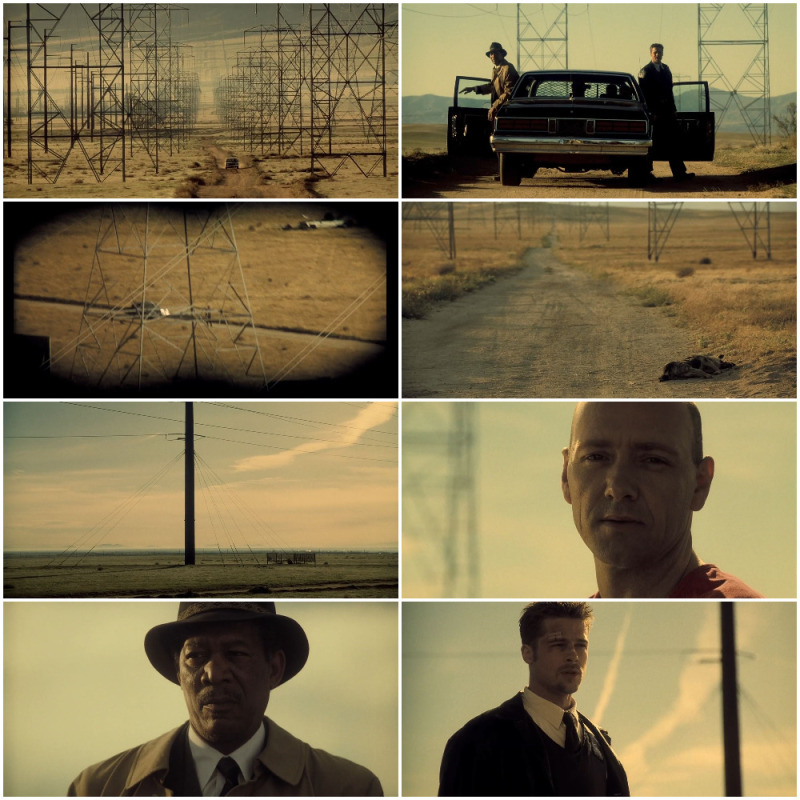
A wide shot of the car boxed in between the menacing structures with 7 written on them and Howard Shore’s foreboding score exudes a “calm before the storm” vibe. The vastness and vacancy of the location are conveyed through establishing shots. John Doe asks for the time and we get a close-up of him saying “It’s close.” Certain about completing his deadly circle, he leads the way.
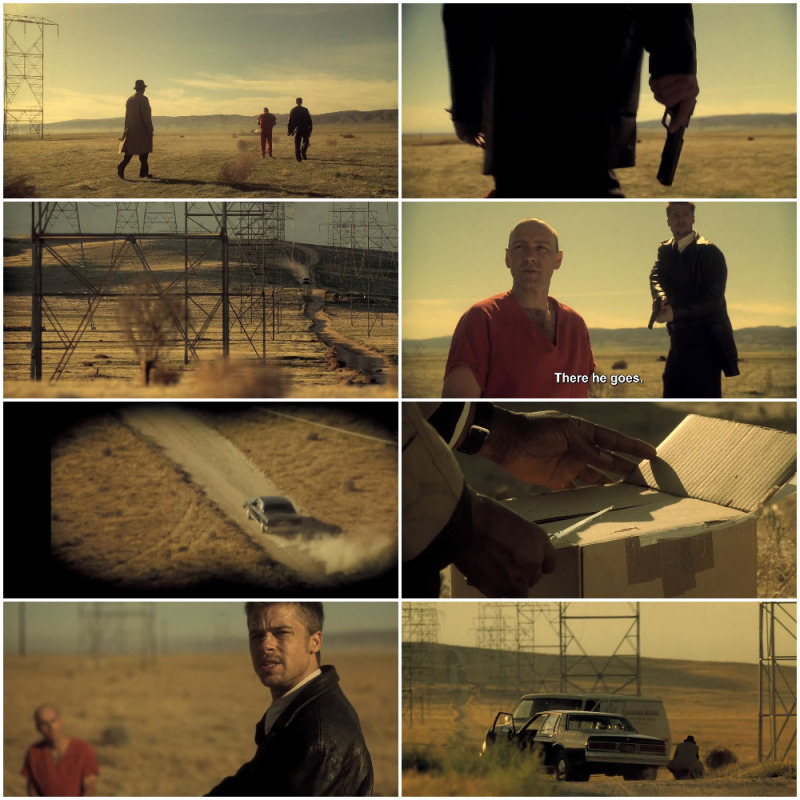
Another instance of how Fincher leads you ahead is evident in this medium shot of the gun in Mills’s hand. It starts to get tense when we see a van on the horizon. Somerset drives towards it while Mills stays with John Doe. A POV shot from helicopter stimulates the scene to a higher degree. The music stops as Somerset starts to open the box. Nothing but the ambient sounds can be heard, further amplifying the apprehensive nature of the scene. John Doe tries to get Mills’s attention, but he keeps ignoring him. This is highlighted by a two-shot with John Doe being out of focus.
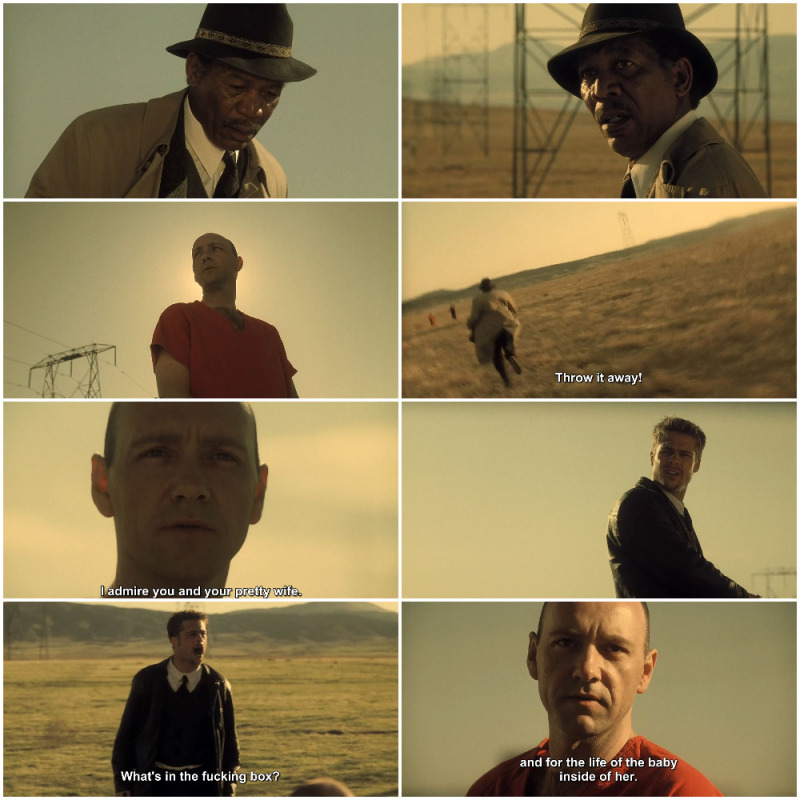
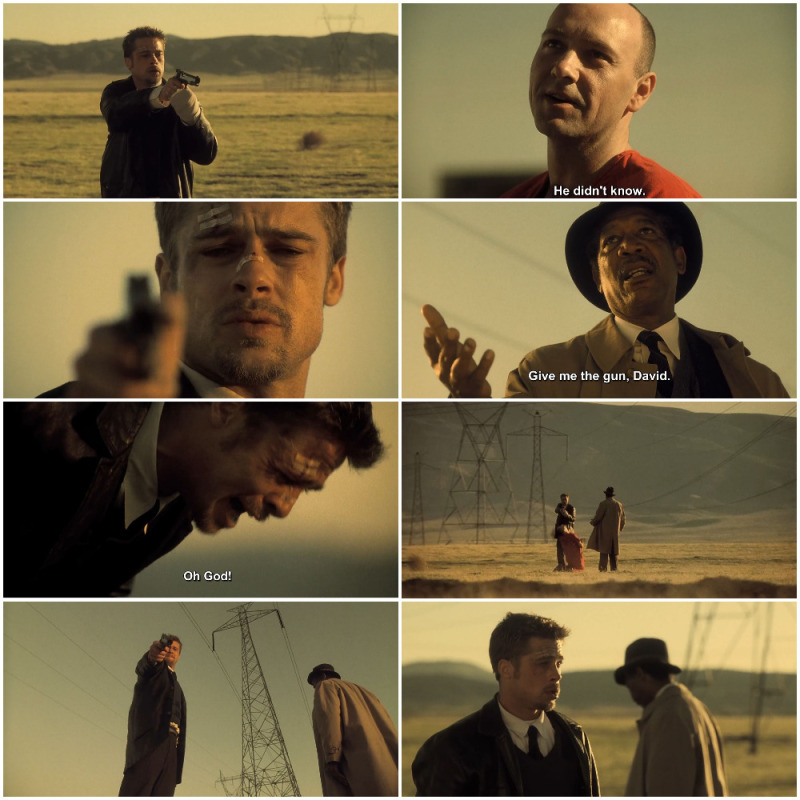
Somerset opens the box and jolts. Ponders for a few seconds and then, as the ear-splitting score hits, runs towards Mills shouting “throw it away.” And again, Fincher saves the handheld camera for the most tremulous moment. A low angle shot from John Doe with aureole around his head signifies that he as an almighty power in full control. Mills, who was ignoring him, is shocked when he utters “I admire you and your pretty wife.” Doe continues telling story. Catching his breath, Somerset reaches the two while Mills, in denial, screams “what’s in the box?!” The camera is shaky between Somerset and Mills, but absolutely stable and smooth on John Doe, conveying the power dynamic. He incapacitates Mills by saying “He begged for her life and the life of the baby inside of her.” Fincher saves the close-up for Mills’s shell-shocked reaction about the baby. John Doe, with a brutal grin, realizes Mills didn’t know.
At this point, Mills wants to kill Doe and he’s trying to fight that urge. He seems to regain control until we see a flash of his wife. Then he unloads his entire clip - seven rounds, naturally - into Doe. The circle is over, as is the relationship between Somerset and Mills, signified with a precise two-shot of their backs at each other.
Final Notes:
- I have shown some scenes with compressed and resized gifs. For a better understanding, I suggest you watch the scenes with the highest quality possible.
- Sources: David Fincher: Interviews, David Fincher: A Life in Pictures.
